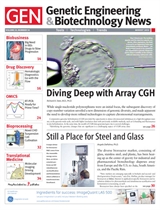Oct 9 2013
New details have emerged about Greatwall, a protein kinase essential for embryonic development and cell cycle progression. To date, most Greatwall studies have used Drosophila models. But now a murine model has been used to show that Greatwall is needed in mammals to prevent mitotic collapse after nuclear envelope breakdown.
This result places Greatwall (also known as Mastl) among a small number of mitotic proteins that are promising anticancer targets. One of the therapeutic advantages Greatwall offers, and one that differentiates it from other mitotic proteins, is that it acts by blocking the function of the PP2A phosphatase, a tumor suppressor frequently altered in human cancer. This implies that the inhibition of Greatwall could, at the same time, slow down cell division and reactivate tumor suppressor PP2A, a protein capable of inhibiting many of the oncogenic molecular pathways involved in cancer development.
The new insights into Greatwall's cellular mechanisms were produced by researchers at the Cell Division and Cancer Group of the Spanish National Cancer Research Centre (CNIO), in collaboration with researchers from the National Centre for Scientific Research (CNRS) in Montpellier, France. The researchers published their results October 7 in the Proceedings of the National Academy of Sciences ("Greatwall is essential to prevent mitotic collapse after nuclear envelope breakdown in mammals").
According to the researchers, led by the CNIO's Marcos Malumbres, Ph.D., "Greatwall-null cells enter into mitosis with normal kinetics. However, these cells display mitotic collapse after nuclear envelope breakdown characterized by defective chromosome condensation and prometaphase arrest."
Essential to the researchers' work was the use of a conditional knockout of the mouse ortholog Mastl. Thanks to this mouse model, they were able to see that cells lacking Greatwall are not capable of adequately dividing themselves. By eliminating Greatwall, cellular DNA does not form the right structure at the moment of cell division, the cell collapses, and cell division cannot continue.
CNIO's research group is already working with other groups and clinical units to find out which tumors might be vulnerable to a strategy that combines mitotic collapse and the reactivation of the tumor suppressor PP2A. Also, the group hopes to develop compounds capable of executing this strategy through the inhibition of Greatwall.
"Therapeutics development is currently in need of novel targets that attack tumors in a different way," said Dr. Malumbres. "Greatwall offers new strategies amongst which can be found reactivating a very important tumor suppressor, something for which there are no direct therapies at the moment."

 This article was reprinted from Genetic Engineering & Biotechnology News (GEN) with permission from Mary Ann Liebert, Inc., publishers. Genetic Engineering & Biotechnology News (GEN) has retained its position as the number one biotech publisher around the globe since its launch in 1981. GEN publishes a print edition 21 times a year and has additional exclusive editorial content online, like news and analysis as well as blogs, podcasts, webinars, polls, videos, and application notes. GEN's unique news and technology focus includes the entire bioproduct life cycle from early-stage R&D, to applied research including omics, biomarkers, as well as diagnostics, to bioprocessing and commercialization.
This article was reprinted from Genetic Engineering & Biotechnology News (GEN) with permission from Mary Ann Liebert, Inc., publishers. Genetic Engineering & Biotechnology News (GEN) has retained its position as the number one biotech publisher around the globe since its launch in 1981. GEN publishes a print edition 21 times a year and has additional exclusive editorial content online, like news and analysis as well as blogs, podcasts, webinars, polls, videos, and application notes. GEN's unique news and technology focus includes the entire bioproduct life cycle from early-stage R&D, to applied research including omics, biomarkers, as well as diagnostics, to bioprocessing and commercialization.